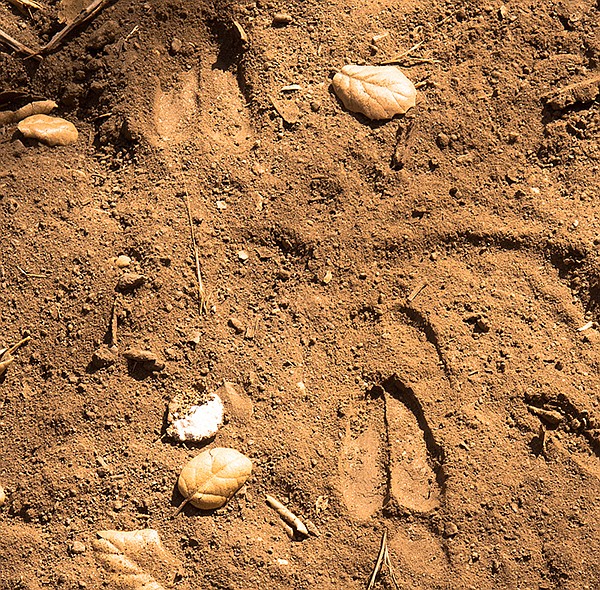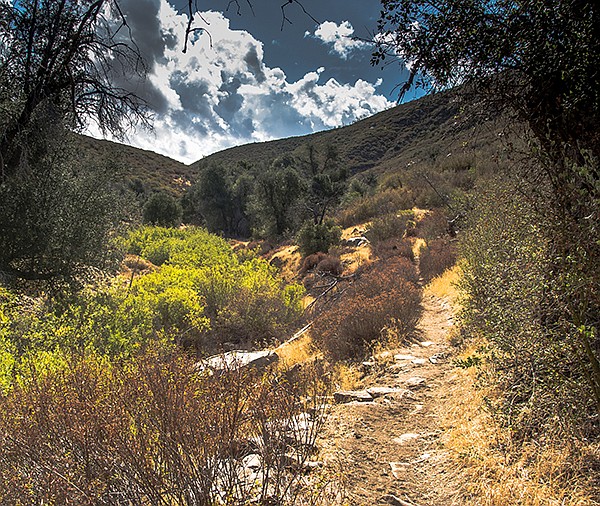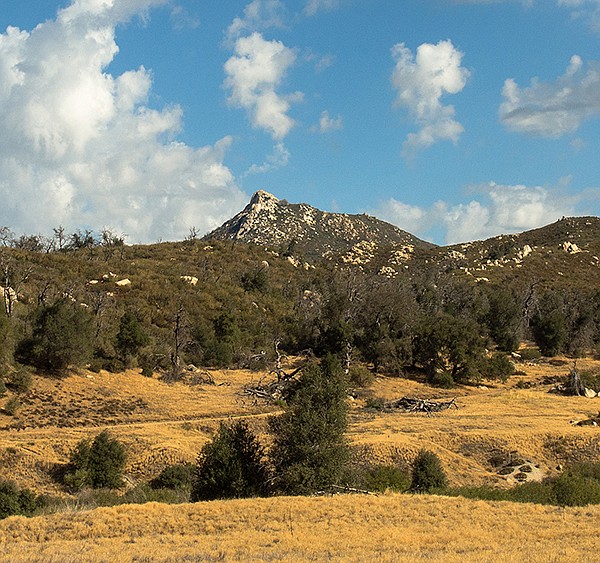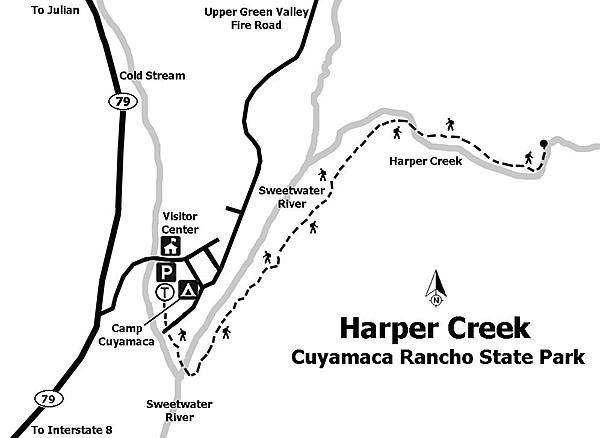 Facebook
Facebook
 X
X
 Instagram
Instagram
 TikTok
TikTok
 Youtube
Youtube




Harper Creek has a series of shallow bathing pools, making it a popular place to enjoy dipping your toes or jumping in this cool mountain stream on hot days. Although both Harper Creek and the Sweetwater River were dry in August 2014, in a normal year both the river and its tributary creek have abundant flowing water, at least in the spring and early summer. The best time to enjoy wildflowers on this hike is from February through June, although there is something blooming practically throughout the year.
The Harper Creek series of pools are about 1.5 miles from the Cuyamaca Rancho State Park Visitor Center. Go south on the Cold Stream Trail from the visitor center day use parking lot through a forest of Jeffrey and Coulter pines interspersed with huge inland live oaks. In about half a mile the trail crosses the Sweetwater River and ascends the bank to join the East Side Trail. Turn left on the East Side Trail and head northeast as it crosses the grassy meadow that flanks the Sweetwater River. Among the non-native annual grasses that cover the meadow will be sand asters, goldenbush, golden yarrow, goldenrod, lupines, mariposa lilies, cream cups, California columbine, tall buckwheat, and many other colorful native wildflowers with blooms, depending on the season and rainfall.

In about 0.75 mile, the East Side Trail enters Harper Creek drainage and continues for a quarter of a mile on the west side of the creek before crossing it. A well-trod use trail leads to the pools that are close to 0.1 mile on up the creek from that point. The Harper Creek trail passes through an oak woodland with scattered inland live oaks mixed with numerous chaparral shrubs, including whitethorn lilac, holly leaf red berry, California wild rose, Palmer lilac, and mountain mahogany. These can put on a colorful show even in the absence of flowing water in the creek. Be on the lookout and avoid poison oak that might be present near the water with an oil urushiol or resin on all surfaces. The extremely variable plant can fool people in that it can look like a small tree (as found in Black Canyon), a climbing vine, or it can grow in thickets, but it can be identified by its leaves, mostly in threes with the terminating leaflet having a short stem. The leaves can be glossy or matte finished with the color ranging from bright green to red. There are small white flowers that, when fertilized, develop cream-colored berries. No matter how attractive do not touch as the urushiol oil can cause rashes or dermatitis upon contact. A safe habit for any age is to follow “leaves of three, let it be” until you can identify this plant. Once you enjoy the pools, return the way you came.
Distance from downtown San Diego: 49 miles. Allow 1 hour driving time. From I-8 E, exit at SR79/Descanso and drive north about 9 miles to the Cuyamaca Rancho State Park Visitor Center. Trailhead parking is just south of the visitor center. Day-use fee required.
Hiking length: 3 miles out-and-back.
Difficulty: Easy. Elevation gain/loss about 200 feet. Facilities and water available at the visitor center. Horses are allowed but no dogs or mountain bikes.





Harper Creek has a series of shallow bathing pools, making it a popular place to enjoy dipping your toes or jumping in this cool mountain stream on hot days. Although both Harper Creek and the Sweetwater River were dry in August 2014, in a normal year both the river and its tributary creek have abundant flowing water, at least in the spring and early summer. The best time to enjoy wildflowers on this hike is from February through June, although there is something blooming practically throughout the year.
The Harper Creek series of pools are about 1.5 miles from the Cuyamaca Rancho State Park Visitor Center. Go south on the Cold Stream Trail from the visitor center day use parking lot through a forest of Jeffrey and Coulter pines interspersed with huge inland live oaks. In about half a mile the trail crosses the Sweetwater River and ascends the bank to join the East Side Trail. Turn left on the East Side Trail and head northeast as it crosses the grassy meadow that flanks the Sweetwater River. Among the non-native annual grasses that cover the meadow will be sand asters, goldenbush, golden yarrow, goldenrod, lupines, mariposa lilies, cream cups, California columbine, tall buckwheat, and many other colorful native wildflowers with blooms, depending on the season and rainfall.

In about 0.75 mile, the East Side Trail enters Harper Creek drainage and continues for a quarter of a mile on the west side of the creek before crossing it. A well-trod use trail leads to the pools that are close to 0.1 mile on up the creek from that point. The Harper Creek trail passes through an oak woodland with scattered inland live oaks mixed with numerous chaparral shrubs, including whitethorn lilac, holly leaf red berry, California wild rose, Palmer lilac, and mountain mahogany. These can put on a colorful show even in the absence of flowing water in the creek. Be on the lookout and avoid poison oak that might be present near the water with an oil urushiol or resin on all surfaces. The extremely variable plant can fool people in that it can look like a small tree (as found in Black Canyon), a climbing vine, or it can grow in thickets, but it can be identified by its leaves, mostly in threes with the terminating leaflet having a short stem. The leaves can be glossy or matte finished with the color ranging from bright green to red. There are small white flowers that, when fertilized, develop cream-colored berries. No matter how attractive do not touch as the urushiol oil can cause rashes or dermatitis upon contact. A safe habit for any age is to follow “leaves of three, let it be” until you can identify this plant. Once you enjoy the pools, return the way you came.
Distance from downtown San Diego: 49 miles. Allow 1 hour driving time. From I-8 E, exit at SR79/Descanso and drive north about 9 miles to the Cuyamaca Rancho State Park Visitor Center. Trailhead parking is just south of the visitor center. Day-use fee required.
Hiking length: 3 miles out-and-back.
Difficulty: Easy. Elevation gain/loss about 200 feet. Facilities and water available at the visitor center. Horses are allowed but no dogs or mountain bikes.